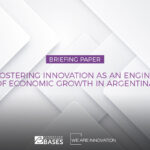After a decade of stagnant social democratic governments in developing countries and a few years of proliferation of radical socialist agendas in developed countries, leaders are emerging who seek to break free from the shackles of suffocating statism. Oxygen pools are beginning to appear gradually in some regions of the world. Under this optimistic view of a more prosperous future for all, freedom is once again a workhorse within public discourse and policies.
The world’s largest economy, the United States of America, is waiting to see what Elon Musk and Vivek Ramaswamy will do and achieve to reduce the bureaucratic apparatus of the State under the new Department of Government Efficiency (D.O.G.E.) of the Donald J. Trump Administration, on the other hand, a debureaucratization agenda is advancing in Argentina, led by economist Federico Sturzenegger of the Ministry of Deregulation and State Transformation under the Javier Milei Administration.
That this type of agenda is a new reason for discussion, after decades of advances in growth and prosperity —and in other cases of inevitable setbacks— reveals the chronic symptoms of the disease of the society of dependency and political and fiscal irresponsibility under the empire of contemporary social democracies. And so, within the same perspective, it is necessary to review the experience that led Chile to leap from being one of the poorest countries on the continent to one of the leading countries in the region. We will refer to the undervalued institution —and somewhat ignored in the same country— the National Commission for Administrative Reform (Conara in Spanish).
Argentina advances with Milei
Through Decree 585/2024, which modifies the Law of Ministries, the Argentine President, Javier Milei, created the Ministry of Deregulation and Transformation of the State. Then, with Decree 586/2024, he appointed the MIT economics doctor Federico Sturzenegger as Minister.
Without a doubt, Argentina faces enormous challenges in reducing permits and regulations and developing a solid and sustainable transformation of the State. This last item, which is not very popular within contingent discussion, supposes the understanding of the internal institutional dynamics and contrast with the regulatory environment and allows a long-term solution that leads Argentina to the regional leadership it had in previous decades.
In this effort, as we have seen, several regulations have been repealed, highlighting the repeal of more than 40 regulations (Resolutions 1212/2024, 433/2024, and 434/24) that regulated industries and 107 previous repeals that made Argentina an unattractive country for investment and that continue the titanic task within the restructuring of ministries and matters of public debt adjustment. In this regard, not only will technocratic work play a role, but it will also play a role in cultural change towards the regulatory environment of Argentines.
The exceptional Chilean case in the 70s
Today, the deregulation agenda is in the spotlight in countries that want to increase their international leadership and provide greater well-being to their citizens. Given these facts, we will investigate one of the institutions that revolutionized this type of agenda, perhaps without sufficient merit, but which should be the subject of university study.
Conara in Chile was one of the first “D.O.G.E.” recorded and has compelling evidence on matters of state reorganization and reduction of bureaucracy in the Western world. Even before developing the modernizing agendas of post-Soviet countries such as Estonia, Poland, and Hungary. Conara, born on December 26, 1973, by Decree Law No. 212, and which was closed after the publication of Law No. 18,201 on April 5, 1983, has a technical-political history worth highlighting. Upon its closure, the Ministry of the Interior became its legal successor by transferring the Division of Modernization and Administrative Reform. To measure such a feat, we must go back to a centralized Chile, where there were no clear competencies of subnational entities and where regional development was not a national issue. So much so that it was only mentioned superficially in “El Ladrillo” by the Chicago Boys when it addresses explicitly a point about the development of intermediate organizations, and that without a doubt, without Conara, the so-called “seven modernizations” that completely changed the course of Chile could not have been developed.
Conara’s vision was clear: to present a policy allowing the country to incorporate an inseparable triad: regionalization, decentralization, and regional development, which, with their nuances and ups and downs, were applied to a greater or lesser extent. To review the bloated public sector, a Restructuring of the Higher Structure of the State Administration was carried out from four points of view: political, economic, legal, and technical-administrative (under the principles of rationality and efficiency). The diagnosis was quite similar to what is currently being proposed in the bureaucratic structures of the countries above: inorganic growth of the State, duplication of functions, political interest groups that favored the inertia and rigidity of the State, and an increase in the interventionist role of the State.
To this end, Conara proposed among its objectives the “rationalization of Public Administration, the reduction of fiscal expenditure, the excessive number of civil servants that make up the public sector and obtaining the maximum use of the resources that it manages” (Conara, 1974), so that “once a real and effective administrative decentralization towards the regions has been carried out, the role of the Ministries must be reviewed and a possible reduction or merger of them can be consolidated, to a number considerably lower than that proposed” (Conara, 1974). As indicated above, it is within the deadlines set by the Commission.
In this regard, Conara presented the reorganization at the ministerial level based on congruence, functionality, and sectorialization criteria, reviewing the entire structure of the State and the duplication of functions. On the other hand, a rationalized view was incorporated on which institutions should be decentralized and decentralized and which should be, in short, merely regional institutions. The above went directly hand in hand with the design of a new superior structure for public administration. The number of public officials per 1,000 inhabitants in Chile in 1976 was 23.4, reduced to 11.1 in 1984. This indicator is 59.5, reflecting a loss of direction in this matter, which is subjected to constant debate in Chile. On the other hand, a profound reform of the political-administrative division was presented with a regional reorganization, creating 13 regions to be able to provide them with greater powers over time and develop their capacities according to their productive vocation without involving an increase in expenses, but rather redirecting resources from the central level to the regional level.
It is worth noting that this process of structural and functional reforms was developed by members of the state apparatus, professionals, experts from academia and civil society organizations such as the College of Architects, and experts from different universities and disciplines. This comprehensive view of reform indicated that “regionalization involves, at the same time as an increase in responsibility, an increase in the real freedom of each person, as a consequence of the elimination of useless bureaucracy lacking social and technical justification.”
Three priority fields were implemented regarding the State’s information systems: accounting standardization, national statistics, and information technology. This work was carried out jointly with the University of Chile. In addition, for the administration of public sector personnel, the Administrative Statute was reformed entirely, the civil service career of public sector workers was regulated, and training plans were implemented (Art. 4° of DFL/90 of 1977) and new forms of qualification, among others.
Furthermore, Conara’s policies made it possible to create a technical mechanism for financing the country’s regions and municipalities, which they did not have then and still have today: the National Regional Development Fund (FNDR) and the Municipal Common Fund (FCM).
Future success must incorporate past learnings
Without a doubt, one of Conara’s successes was its being given powers and trusts from above the ministry, which allowed it to be above the power struggles of the particular leaderships of each sector ministry. Another of its merits is that Conara achieved this with a group of directors, professionals, and administrators that was around 30-40 officials, very different from what can be seen in public departments today. A total commitment to the country, to work to modernize Chile.
In this way, the United States, Argentina, or other countries that join these deregulatory agendas should explore what Conara developed in Chile more than 50 years ago. With the technologies of the time, this represents a pioneering approach to freedom that has not even been measured in our own country, and which today is a reason for discussion of innovation in deregulation and state efficiency.
* Andrés Barrientos is a Civil Engineer with, Master’s in Government Management and a Master’s in Construction Management. He is also a consultant, public policy analyst, and author. He has worked in the private sector in construction and real estate and in the public sector on subnational competitiveness and territorial analysis, serving as a delegate to the OECD in an expert group on multi-level governance and public investment. He is also co-founder of the free-market think tank Ciudadano Austral.
Source: We Are Innovation











